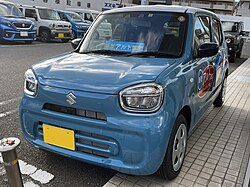Suzuki HEARTECT platform
The HEARTECT platform is an automobile platform that underpins various Suzuki models since 2014.
Construction
The platform is claimed to utilize "Advanced High Tensile Steel" and "Ultra High Tensile Steel", which are intended to increase occupant safety in case of a collision. Suzuki also claims that the platform offers increased body stiffness, allowing for better ride quality and handling. Additionally, via a reduction in weight of up to 30 kg (66 lb), the platform helps achieve an improved power to weight ratio.
The platform is shown to utilize MacPherson strut front suspension.
A derivative platform for battery electric vehicles, named Heartech-e, was first introduced on the e Vitara in 2024.
Applications
Kei cars
- Suzuki Alto / Mazda Carol (2014–present)
- Suzuki Lapin (2015–present)
- Suzuki Wagon R / Mazda Flair (2017–present)
- Suzuki Spacia / Mazda Flair Wagon (2017–present)
- Suzuki Hustler / Mazda Flair Crossover (2020–present)
- Suzuki Wagon R Smile (2021–present)
- Suzuki Hustler
- Suzuki Alto
- Suzuki Lapin
- Suzuki Wagon R
- Suzuki Spacia
- Suzuki Wagon R Smile
Subcompact cars
- Suzuki Baleno / Toyota Glanza / Starlet (2015–present)
- Suzuki Solio / Mitsubishi Delica D:2 (2015–present)
- Suzuki Ignis (2016–present)
- Suzuki Swift (2016–present)
- Suzuki Dzire (2017–present)
- Suzuki Xbee (2017–present)
- Maruti Suzuki Wagon R (2019–present)
- Suzuki S-Presso (2019–present)
- Suzuki Celerio / Toyota Vitz (2021–present)
- Maruti Suzuki Alto K10 (2022–present)
- Suzuki Fronx / Toyota Urban Cruiser Taisor/ Starlet Cross (2023–present)
- Suzuki Baleno
- Suzuki Solio
- Suzuki Ignis
- Suzuki Swift
- Suzuki Dzire
- Suzuki Xbee
- Maruti Suzuki Wagon R
- Suzuki S-Presso
- Suzuki Celerio
- Maruti Suzuki Alto K10
- Suzuki Fronx
Compact cars
- Suzuki Ertiga / Toyota Rumion (2018–present)
- Suzuki XL6/XL7 (2019–present)
- Suzuki Ertiga
- Suzuki XL7


















